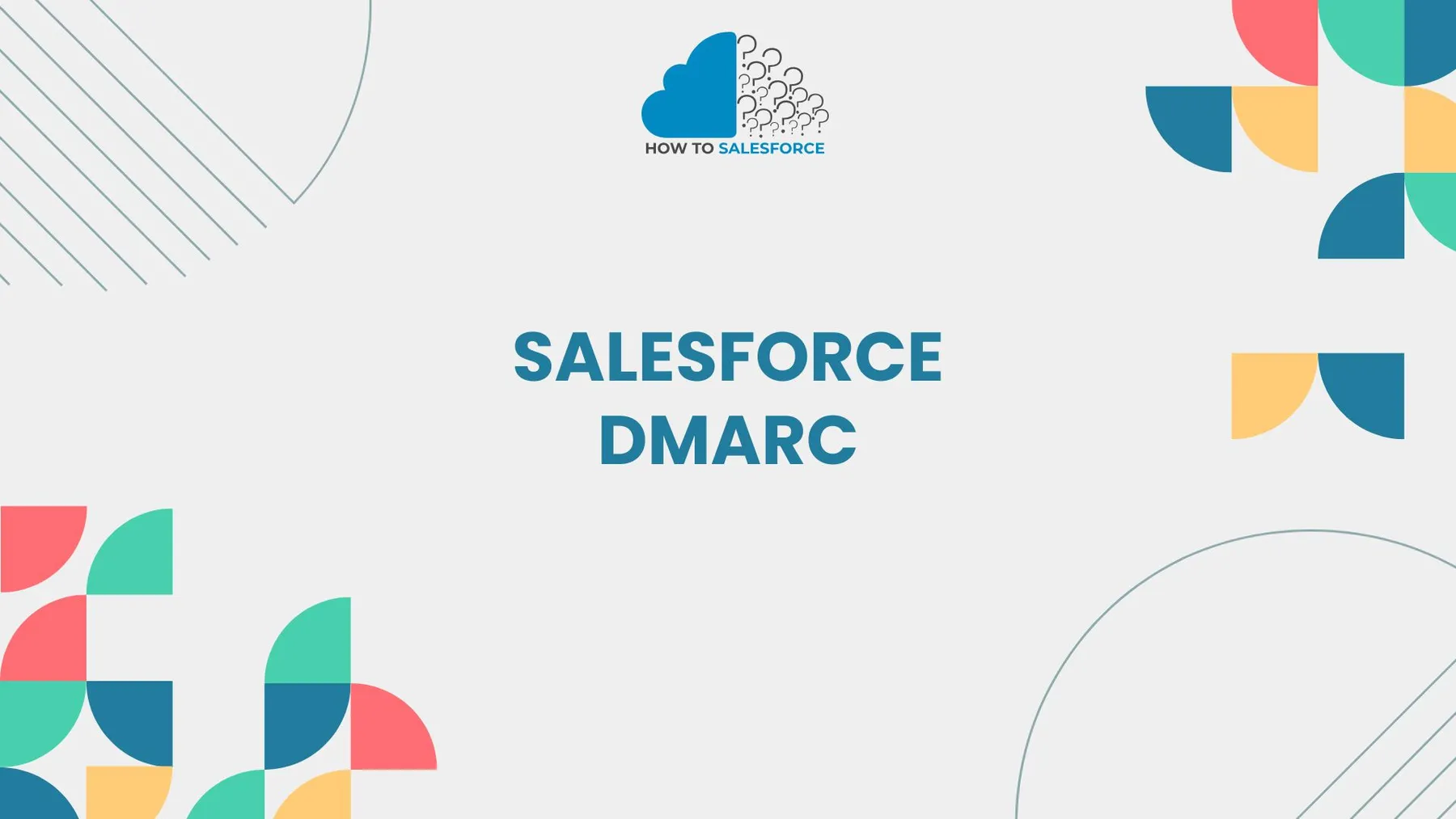Introduction to Salesforce DMARC
DMARC is necessary to ensure corporate emails are secure. Salesforce DMARC prohibits illegal use, phishing, and email spoofing. Implementing DMARC enhances deliverability and customer trust. It guarantees that emails sent to your domain can only be sent by authorized senders.
Wanna read more? Here’s my other blog: Salesforce Task Object
Why DMARC Matters for Salesforce Users
Businesses use emails to communicate. However, cyber threats, such as spoofing and phishing, are on the rise. DMARC assists in thwarting these dangers, which is why it is so important.
- Prevents Email Spoofing: Guards against unsanctioned emails sent to your domain.
- Enhances Deliverability: Guarantees that authentic emails arrive in recipients’ inboxes.
- Builds Trust: Gives your emails more credibility with your clients.
- Offers Reports: Provides information about email authentication.
These benefits help secure your Salesforce emails.
Understanding DMARC
SPF (Sender Policy Framework) and DKIM (DomainKeys Identified Mail) are the two primary protocols used by DMARC. Emails are validated by these protocols:
- SPF: Verifies that the sender of the email is authorized.
- DKIM: Uses a digital signature to verify the integrity of email content.
- DMARC: For domain alignment, combine DKIM and SPF checks.
When an email fails DMARC, it can be rejected or quarantined.
Setting Up DMARC for Salesforce Emails
Follow these steps to set up DMARC:
- Create a DMARC Record: Log in to your DNS provider.
- Add a TXT Record: Use the TXT record type to enter DMARC settings.
- Configure Policies: Set policies to none, quarantine, or reject.
- Set Reporting: Make forensic and aggregate reports available.
- Monitor Results: Examine reports frequently to make necessary adjustments.
This setup helps protect your domain from email fraud.
Best Practices for Implementing Salesforce DMARC
Use these best practices to get the most out of it:
- None Policy at First: Start in monitoring mode.
- Move Gradually to “Reject”: As problems decrease, enforce more.
- Use SPF and DKIM: Verify that both protocols are set up properly.
- Monitor Reports: Examine DMARC reports regularly.
- Test Emails: Ensure emails pass DMARC checks before sending.
Following these steps ensures smooth implementation.
Common Challenges in DMARC Implementation
Despite its effectiveness, DMARC has drawbacks.
- Complex Setup: Technical expertise is needed.
- False Positives: At first, legitimate emails might be blocked.
- Ongoing Monitoring: Requires frequent updates and inspections.
- Third-Party Senders: DMARC may not be passed by external services.
Appropriate planning and monitoring are necessary to address these issues.
Benefits of Using DMARC in Salesforce
Salesforce users can benefit greatly from DMARC implementation:
- Prevents Phishing: Prevents hackers from pretending to be your company.
- Boosts Deliverability: This makes it more likely that emails will arrive in recipients’ inboxes.
- Improves Analytics: Offers insight into the effectiveness of emails.
- Boosts Brand Reputation: Increases consumer trust.
- Decreases Spam Complaints: Reduces the likelihood of being flagged as spam.
DMARC is crucial for email security because of these benefits.
How DMARC Affects Email Marketing in Salesforce
Deliverability is a key component of email marketing. DMARC enhances Salesforce email campaigns by:
- Increasing Open Rates: Lowers spam filtering of emails.
- Maintaining Consistency: Enhances the credibility of emails.
- Reducing Bounces: Lowers hard bounce rates.
- Tracking Engagement: Improved understanding of email exchanges.
These improvements boost overall marketing effectiveness.
Automating DMARC Monitoring in Salesforce
Time is saved by automation. Tools for automating DMARC reporting can be integrated with Salesforce. This procedure consists of:
- Integrate with Tools: Make use of Agari or DMARCIAN, two DMARC reporting services.
- Set Alerts: Set up automated notifications when DMARC checks are unsuccessful.
- Create Reports: Plan for monthly or weekly reports.
- Analyze Data: For deeper insights, use dashboards.
Automation helps maintain consistent email security.
Salesforce DMARC vs. SPF and DKIM
Email security is improved by DMARC, SPF, and DKIM. This is an analogy:
- SPF: Verifies the IP addresses of senders.
- DKIM: Guarantees the integrity of the content.
- DMARC: Integrates both for reporting and alignment.
When combined, they produce a safe email environment.
Steps to Transition from None to Reject
Gradually increasing enforcement is key. Here’s how:
- Begin with a None Policy: Gather information without preventing emails.
- Examine Reports: Determine who are the authentic senders.
- Go to Quarantine: Put shady emails in spam mailboxes.
- Apply Reject: Lastly, stop unsanctioned emails.
- Continuous Monitoring: Make sure that no valid emails are blocked.
This phased approach minimizes disruptions.
Using Salesforce DMARC Reports Effectively
DMARC reports offer insightful information. How to use them is as follows:
- Review Aggregate Reports: Check for failed emails.
- Examine Forensic Reports: Seek out particular problems.
- Identify Trends: Look for trends in unsuccessful emails.
- Adjust Policies: Adjust parameters in response to reports.
- Optimize Sender Lists: Update authorized senders.
Proper report analysis enhances email security.
Salesforce DMARC
Ensuring compliance with DMARC is essential. Here’s how:
- Document Policies: Document how you set up DMARC.
- Train Teams: Provide email security education to teams.
- Continually Monitor: Arrange for monthly compliance audits.
- Use Third-Party Audits: Hire experts for reviews.
- Update Protocols: Modify configurations in response to evolving regulations.
Compliance guarantees strong security and helps prevent fines.
Tips for Optimizing DMARC in Salesforce
Here are some quick tips:
- Test Frequently: Before deployment, always test DMARC modifications.
- Keep SPF Records Short: Keep entries to a minimum to prevent DNS errors.
- Enable DKIM for All Emails: Ensure signatures on all outbound emails.
- Use Subdomains: Use subdomains to keep marketing emails apart.
- Leverage Analytics: For deeper insights, use Salesforce reports.
These optimizations ensure smooth email delivery.
Conclusion
Salesforce DMARC assists in defending your company against email attacks. Businesses can increase customer trust, improve deliverability, and protect their domain by putting DMARC into practice. To maximize performance, begin with monitoring, then progressively implement policies and use reports. Robust email security for your Salesforce environment is ensured by regular monitoring and updates.


